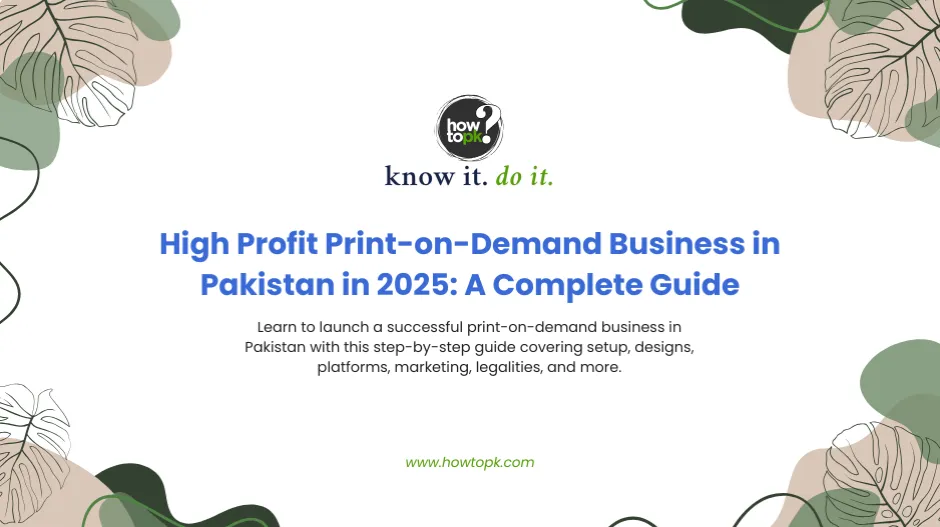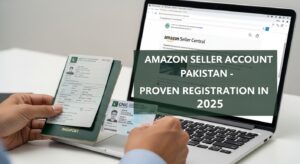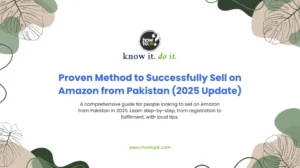Starting an online business in Pakistan has never been easier, and among the many exciting opportunities, Print-on-Demand (POD) stands out. Imagine selling custom-designed products like T-shirts, mugs, phone covers, or even art prints, without the headache of managing inventory, production, or shipping. That’s the magic of Print-on-Demand!
This comprehensive guide is designed specifically for you, whether you’re a seasoned entrepreneur or an absolute beginner with a creative spark. We’ll walk you through every step of establishing a thriving Print-on-Demand business right here in Pakistan, from concept to cash.
Get ready to turn your artistic ideas into real, tangible products and build a profitable venture without breaking the bank or dealing with complex logistics. Let’s get started!
Step 1: Understand the Print-on-Demand Business Model
What is Print-on-Demand?
Print-on-Demand is an e-commerce model where you sell products with your custom designs, but you don’t actually print or stock any inventory yourself. Instead, when a customer places an order, it’s sent directly to a third-party POD service provider. This provider prints your design onto the chosen product, packages it, and ships it directly to your customer.
Why is Print-on-Demand Ideal for Pakistan?
This model is particularly suited for the Pakistani market for several reasons:
- Low Startup Costs: You don’t need significant capital to buy inventory or printing equipment, reducing your financial risk.
- No Inventory Management: Say goodbye to warehousing, managing stock levels, or worrying about unsold items.
- Wide Product Range: Easily offer a diverse catalog, from apparel to home decor, without needing specialized machinery for each.
- Flexibility and Scalability: You can start small, test designs, and quickly scale up without logistical nightmares.
- Focus on Creativity and Marketing: Your primary role is to create compelling designs and market your brand, leveraging your artistic and business skills.
How the Print-on-Demand Process Works
The flow is quite straightforward:
- You create unique designs.
- You choose a Print-on-Demand service provider and integrate your online store with their platform.
- You select products from their catalog (e.g., T-shirts, mugs, posters) and apply your designs to them.
- You list these designed products on your online store (e.g., Shopify, WooCommerce).
- A customer visits your store, likes a product with your design, and places an order.
- The order automatically goes to your Print-on-Demand provider.
- The provider prints the design on the product, packages it, and ships it directly to your customer.
- You pay the POD provider their base cost for the product and printing, and you keep the profit margin (your selling price minus the base cost and shipping fees).
Step 2: Niche Down and Identify Your Target Audience
Why a Niche is Crucial
In a competitive market, trying to sell everything to everyone is a recipe for struggle. A clear niche helps you:
- Stand Out: You become known for something specific, attracting loyal customers.
- Target Marketing: Your marketing efforts become more focused and effective, saving you time and money.
- Design Cohesion: It’s easier to create consistent designs that resonate with a specific group.
How to Find Your Niche in Pakistan
Think about what you’re passionate about, what problems you can solve, or what unique cultural elements you can incorporate.
- Local Trends: Are there popular Pakistani sayings, cultural references, or regional symbols that people would love on products? Think about Urdu calligraphy, traditional art motifs, or humorous local phrases.
- Specific Hobbies/Interests: Target gamers, book lovers, pet owners, fitness enthusiasts, or fans of specific Pakistani dramas or music.
- Demographics: Consider designs for students, young professionals, mothers, or children. Each group has unique preferences.
- Problem Solving: Can your designs offer a solution or express a sentiment? For example, designs promoting environmental awareness, national pride, or social causes.
- Current Events/Pop Culture: Capitalize on trending events, festivals (Eid, Basant), or popular memes, but be mindful of copyright.
Once you have a few ideas, do some informal market research. Talk to potential customers, browse local online marketplaces, and see what’s already out there and where there might be gaps.
Step 3: Create Winning Designs
The Heart of Your Print-on-Demand Business
Your designs are your product. High-quality, unique, and appealing designs are what will attract customers and make your brand memorable.
Designing Your Products
- Understand Design Principles: Learn the basics of color theory, typography, composition, and visual hierarchy.
- Use Appropriate Tools: Familiarize yourself with graphic design software. Free tools are available if you’re on a budget.
- High-Resolution Files: Always work with high-resolution images (DPI: Dots Per Inch) to ensure your prints come out crisp and clear. Most POD providers recommend 300 DPI.
- Design for the Product: A design that looks great on a T-shirt might not work as well on a mug. Consider the product’s shape, size, and material when designing.
- Originality is Key: Do not copy copyrighted or trademarked designs. This can lead to serious legal issues and harm your business’s reputation. Create your own unique artwork or use licensed assets.
Outsourcing Designs (If Needed)
If you’re not a designer, don’t worry! You can hire freelancers in Pakistan or globally to create designs for you. Look for talent on local freelance platforms or international ones. Clearly communicate your niche, vision, and brand aesthetic.
Step 4: Choose the Right Print-on-Demand Provider in Pakistan
The Backbone of Your Operations
This is one of the most critical decisions. Your POD provider handles everything from printing to shipping, so their reliability directly impacts your customer satisfaction.
Key Factors to Consider When Choosing a Provider
- Location: While international providers offer global reach, local Pakistani providers might offer faster shipping times within Pakistan and easier cash-on-delivery (COD) options.
- Product Range: Do they offer the products you want to sell (T-shirts, hoodies, mugs, phone cases, wall art, etc.)?
- Print Quality: Ask for samples or check reviews to ensure their print quality is consistently high. This directly reflects on your brand.
- Pricing and Profit Margins: Compare base product costs and printing fees. Calculate your potential profit margins for different products.
- Shipping Times and Costs: Understand their typical fulfillment and shipping times, especially for deliveries within Pakistan. Are their shipping costs competitive?
- Integration: Do they seamlessly integrate with your chosen e-commerce platform (e.g., Shopify, WooCommerce, or a local marketplace)?
- Customer Service: Do they offer responsive support in case of issues with orders or products?
- Cash-on-Delivery (COD) Option: For the Pakistani market, offering COD is almost essential. Many local POD providers facilitate this. Confirm if your chosen provider offers COD payment collection and how they remit funds to you.
Popular Print-on-Demand Options for Pakistan
You have a few choices:
- Local Pakistani Providers: These often offer better shipping times and COD for local customers. Examples include CeePrinto, Dexpel, and Ink Factory. They understand the local logistics landscape well.
- International Providers with Pakistani Fulfillment: Some global POD companies might have fulfillment centers or partners in Pakistan, or offer reasonable international shipping. Always check their specific services for Pakistan.
- International Providers Shipping to Pakistan: These are typically larger platforms. While they offer a vast product range, be mindful of longer shipping times, potential customs duties for your customers, and limited COD options.
Do thorough research, read reviews, and perhaps order a sample product from a few shortlisted providers to check their quality firsthand before committing.
Step 5: Set Up Your Online Store
Your Digital Shopfront
This is where your customers will browse your products and make purchases. There are several ways to set up an online store in Pakistan.
Choosing Your E-commerce Platform
- Shopify: A globally popular and user-friendly platform. It’s excellent for beginners, offers many themes, and integrates with most POD providers. It has a monthly fee but provides a robust and scalable solution.
- WooCommerce (for WordPress): If you already have a WordPress website or prefer more control, WooCommerce is a free plugin that turns your site into an e-commerce store. It requires a bit more technical setup but offers immense flexibility.
- Local E-commerce Marketplaces: Consider selling on platforms popular in Pakistan like Daraz.pk. While they offer a built-in audience, they also have their own fees and rules. Some POD providers might integrate directly with these marketplaces.
- Social Media Shops: For a very basic start, you can use Facebook Shops or Instagram Shopping. However, for a professional look and full functionality, a dedicated e-commerce platform is recommended.
Key Considerations for Your Store
- Domain Name: Choose a memorable and relevant domain name (e.g., yourbrandname.pk). This is your online identity.
- Store Design: Select a clean, attractive, and mobile-responsive theme. Ensure it’s easy for customers to navigate, find products, and checkout.
- Product Listings: Write compelling product descriptions that highlight your unique designs, product features, and benefits. Use high-quality mockups of your products. Most POD providers offer mockup generators.
- Pricing Strategy: Set your prices competitively but ensure they cover the POD provider’s cost, shipping, your platform fees, marketing expenses, and leave you a healthy profit margin.
Step 6: Set Up Payment Gateways
Enabling Transactions in Pakistan
This is a critical step to ensure your customers can pay you seamlessly. In Pakistan, a mix of traditional and digital payment methods is preferred.
Local Payment Methods are Essential
- Cash on Delivery (COD): This is the most prevalent payment method in Pakistan. Many customers prefer to pay upon receiving their order. Ensure your POD provider or a separate logistics partner offers COD collection.
- Bank Transfers/EasyPaisa/JazzCash: These mobile wallet solutions are widely used. You can offer direct bank transfers or integrate with these services.
Integrating Online Payment Gateways
For card payments and other digital transactions, you’ll need a payment gateway. Here are some options:
- Local Bank Gateways: Major Pakistani banks like Bank Alfalah (Alfa Payment Gateway), HBL, UBL, and MCB offer e-commerce payment gateway services. You’ll typically need a registered business and a bank account to apply.
- Local FinTech Payment Gateways: Companies like Safepay, PayPro, and XPay provide easy-to-integrate payment solutions, often supporting multiple payment methods including cards, bank transfers, and mobile wallets.
- International Payment Gateways (Limited): While options like PayPal are not fully operational for receiving payments in Pakistan, some international gateways might work for cross-border transactions, but local solutions are generally preferred for Pakistani customers.
Important Notes on Payments
- Security: Ensure your payment gateway is secure to protect your customers’ financial information.
- Fees: Understand the transaction fees charged by each payment gateway. These will impact your profit margins.
- Integration: Check if the payment gateway integrates smoothly with your chosen e-commerce platform.
Step 7: Master Shipping and Logistics
Delivering Your Designs to Your Customers
While your POD provider handles the physical shipping, understanding the logistics is crucial for setting customer expectations and managing costs.
How Shipping Works with Print-on-Demand
Your POD provider will typically handle the shipping. When an order comes in:
- They print and package the product.
- They then use their chosen courier partners to deliver the product.
- You’ll usually receive tracking information that you can share with your customer.
Key Shipping Considerations for Pakistan
- Shipping Costs: These are often passed on to the customer or absorbed by you, impacting your pricing. Clearly display shipping costs on your website.
- Delivery Times: Be transparent about estimated delivery times. Local POD providers often offer 3-5 business day delivery within Pakistan, while international ones might take longer.
- Cash on Delivery (COD): If offering COD, confirm with your POD provider how they manage COD collection and fund remittance to you. This is vital for the Pakistani market.
- Tracking: Provide customers with tracking numbers so they can monitor their orders.
- Returns and Refunds: Establish a clear return and refund policy, especially concerning quality issues or damaged products, as these are often handled by the POD provider.
Tips for Smooth Logistics
- Communicate Clearly: Set realistic expectations with your customers regarding shipping times and any potential delays.
- Monitor Tracking: Keep an eye on your order statuses to quickly address any issues.
- Customer Service: Be prepared to handle customer inquiries about their deliveries.
Step 8: Marketing Your Print-on-Demand Business in Pakistan
Getting Your Designs Seen
Even with great designs and a perfect setup, your business won’t succeed without effective marketing. This is where you connect with your target audience.
Essential Marketing Strategies
| Strategy | Details |
|---|---|
| Social Media Marketing | Most powerful tool in Pakistan. Focus on Facebook, Instagram, TikTok, and YouTube. |
| Content | Share high-quality photos/videos of products. Show people using them in everyday Pakistani settings. |
| Engagement | Run polls, ask questions, respond to comments, and use hashtags like #PakistanFashion, #MadeInPakistan, #PakistaniArt. |
| Paid Social Ads | Use targeted Facebook & Instagram ads to reach specific demographics and interests in Pakistan. |
| Influencer Marketing | Collaborate with local influencers (especially micro-influencers) who align with your niche. |
| Search Engine Optimization (SEO) | Use Pakistan-specific keywords in product titles/descriptions (e.g., custom t-shirts Lahore, Pakistani art prints online). |
| Content Marketing | Start a blog: share niche topics, design inspirations, or behind-the-scenes stories. |
| Email Marketing | Collect emails (with consent) and send newsletters about new designs, promotions, or offers. |
| Paid Advertising (Google Ads) | If budget allows, run Google Shopping Ads or Search Ads for specific product searches. |
| Local Events / Pop-ups | Join bazaars, exhibitions, university events to connect offline and build brand trust. |
| Customer Reviews & Testimonials | Encourage customers to leave reviews and share product photos for social proof. |
| Urdu Content | Use Urdu in product descriptions or social posts to connect with a wider audience. |
| Seasonal Campaigns | Run campaigns around Eid, Basant, Independence Day, wedding season, etc. |
| Cultural Relevance | Include Pakistani culture, humor, and traditions in designs and marketing messages. |
Step 9: Legal and Financial Compliance in Pakistan
Operating Your Business Legally
Even a small online business needs to comply with local laws and regulations. Don’t let this step intimidate you; it’s essential for long-term success and credibility.
| Area | Key Points |
|---|---|
| Business Registration | • Sole Proprietorship – simplest, common for small businesses, less complex. • Partnership Firm – for multiple owners, registered with Registrar of Firms. • Private Limited (Pvt. Ltd.) – for larger operations or investment, registered with SECP, offers limited liability. ➝ For most Print-on-Demand startups, sole proprietorship is enough. Consult a lawyer/consultant if unsure. |
| National Tax Number (NTN) & FBR Registration | • NTN mandatory for all business owners (needed for tax compliance, business bank account, credibility). • Apply online via FBR IRIS portal with CNIC, mobile number, email, business details. • Sales Tax Registration required if turnover crosses threshold. • File regular tax returns to avoid penalties. |
| Intellectual Property (IP) Rights | • Copyright – protects original designs automatically; registration strengthens legal protection. • Trademark – register brand name & logo with IPO-Pakistan to prevent misuse. • Ensure designs don’t infringe on others’ copyrights/trademarks. |
| Consumer Protection Laws | • Follow transparent pricing, accurate descriptions, clear return/refund policies, and fair trading practices. |
| Bank Account | • Open a separate business bank account (even for sole proprietors) to keep finances clear and simplify tax/accounting. |
Step 10: Manage and Grow Your Business
| Area | Key Practices |
|---|---|
| Order Management | • Monitor orders on your store/POD dashboard. • Send order confirmations, shipping updates, and thank-you notes. • Handle inquiries, delivery issues, or defects promptly. |
| Customer Service | • Respond quickly via email, WhatsApp, or social media. • Maintain polite, professional communication. • Resolve problems effectively, even if extra coordination with POD providers is needed. |
| Financial Management | • Track all income and expenses (sales, POD costs, shipping, marketing, platform fees). • Monitor profit margins regularly and adjust pricing if needed. • Reinvest profits into designs, marketing, or store upgrades. |
| Scaling Your Business | • Expand product range gradually within your niche. • Create fresh designs consistently. • Explore new or related niches (possibly under a new brand). • Build customer loyalty through discounts, loyalty programs, and community-building. • Collect and act on customer feedback to improve offerings. |
Conclusion
Starting a Print-on-Demand business in Pakistan offers a fantastic low-risk, high-reward opportunity for creatives and entrepreneurs. By understanding the local market, focusing on unique designs, choosing reliable partners, and effectively marketing your brand, you can build a successful and fulfilling online venture.
It requires dedication, continuous learning, and a passion for your craft, but the satisfaction of seeing your designs come to life and reach customers across Pakistan is truly rewarding. So, take the leap, unleash your creativity, and embark on your Print-on-Demand journey today. Best of luck!
Resources
- Print-on-Demand Providers in Pakistan:
- CeePrinto
- Dexpel
- Ink Factory
- (Always search for current local providers as the market evolves)
- E-commerce Platforms:
- Shopify
- WooCommerce (for WordPress)
- Daraz.pk (as a marketplace option)
- Payment Gateways in Pakistan:
- Alfa Payment Gateway (Bank Alfalah)
- HBL, UBL, MCB Payment Gateways
- Safepay
- PayPro
- XPay
- JazzCash
- EasyPaisa
- Government Bodies for Business Registration & Taxation:
- Securities and Exchange Commission of Pakistan (SECP)
- Federal Board of Revenue (FBR)
- Intellectual Property Organization of Pakistan (IPO-Pakistan)
- Graphic Design Tools (Examples):
- Adobe Photoshop / Illustrator
- Canva
- GIMP (Free)
- Inkscape (Free)
- Freelancing Platforms for Designers (Examples):
- Fiverr
- Upwork
- Guru
- Local Pakistani freelance groups on Facebook



